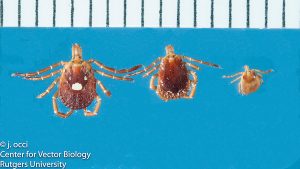
Study Confirms Heartland Virus in Lone Star Ticks in Georgia
 The report of a human death in Georgia from Heartland virus (HRTV) as well as confirmed white-tailed deer exposure to the tick-borne pathogen prompted researchers to collect samples of questing ticks in 2018–2019. The samples were taken from 26 sites near the areas where seropositive deer were captured, as well as the residence of the human patient.
The report of a human death in Georgia from Heartland virus (HRTV) as well as confirmed white-tailed deer exposure to the tick-borne pathogen prompted researchers to collect samples of questing ticks in 2018–2019. The samples were taken from 26 sites near the areas where seropositive deer were captured, as well as the residence of the human patient.
The researchers processed a total of 9,294 Amblyomma Americanum (lone star) ticks in pools by virus isolation in Vero E6 cells and reverse transcription PCR. The positive pools went through whole-genome sequencing with three pools showing the presence of HRTV (minimum infection rate 0.46/1,000 ticks). Cell cultures found HRTV in two pools while none of the ticks tested positive for Bourbon virus. Among the samples, the genome sequencing for the three HRTV isolates exhibited a high degree of similarity, however, there were significant differences with formerly sequenced HRTV isolates.
HRTV was first detected in 2009 and since then approximately 40 more human cases of the disease have been discovered in Missouri, Kansas, Oklahoma, Arkansas, Iowa, Illinois, Tennessee, Indiana, and South Carolina, and, as this study confirms, Georgia. Most of these cases involved patients who had comorbidities and for many, their diseases were serious or deadly.
Studies showing seroprevalence in wildlife suggest an even wider distribution range of HRTV than those states with reported human disease cases. The researchers advise clinicians and those working in public health to be aware of this tick-borne pathogen as it emerges.
Read the study in the CDC’s Emerging Infectious Diseases journal.
Read more about Heartland virus.
Read more about lone star and other tick vectors.





